With some time to kill before we make our to New Zealand and on the recommendation of Clair’s cousin Avery, we decided to venture into Uruguay. Can anyone tell us anything they know about this country? Anyone? Anyone? If not, you’re not alone. Most backpackers seem to skip this country and at first glance we understand why. There’s no “Macchu Picchu” of Uruguay and this is probably the most expensive country in Central and South America. So what makes Uruguay special? Well grab your gourd, thermos, yerba mate, and chill out because this country has a lot to offer!
With a population 3 million, and 1.5 million in the capital Montevideo, every city has that small-town feel (like a large and less French and more Spanish Notre-Dame-de-Lourdres). No-one has their dog on a leash and every driver does the four-finger steering wheel wave (if you don’t know what that is you need to take a tour of rural Manitoba with Kik). This is a front-porch sitting kinda place, where friends enjoy a shared mate and watch futbol like it’s their religion.
Couple of things to note. First off, pay with a credit card wherever possible in Uruguay because for some reason this exempts you from an 11% tax. Second, we found ATMs easier to access here but there is a rather low limit and high charge when you use them. Third, everywhere you go you will see people with a thermos and cup of mate. EVERYWHERE. Driving. Biking. On the bus. Everywhere! We recommend you give it a go. Here’s a video to learn how to drink mate like a pro and not embarrass yourself! It’s more complicated than you think! Fourth, Uruguay is considered one of the most safe and progressive countries in Central and South America. Straddled between Brazil and Argentina, Uruguay has a very distinct set of values that sometimes aggravate their more traditional and religious neighbors. Uruguay has legalized same-sex marriage, is pro-choice, and most recently are moving to even further reduce the limited restrictions on the sale and use of marijuana. With about 60% of Uruguayans identifying as agnostic, this is definitely the least religious country we visited so far.
Day 1/2– Colonia del Sacremento
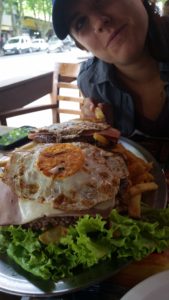
A very popular way to travel between Argentina and Uruguay is by ferry across the Rio de la Plata. There are three major companies; Buquebus, Colonia, and Sea Cat, that all offer daily trips. We chose to use Sea Cat, as they offered the cheapest prices but oddly enough still used the Buquebus launch site and boat ($60 CAD/person). If you’re on a tight budget there’s a cheaper ferry, but it takes about three hours to cross instead of one. Our first destination was Colonia del Sacramento, which is directly across the delta from Buenos Aires. You can choose to bypass Colonia del Sacramento and purchase a ticket to go directly to Montevideo, but the quiet little town is worth a stop. The first thing we noticed was how the rules of the road had changed! Cars stopped for pedestrians, drove the speed limit, and didn’t excessively use the horn! We felt like we had forgotten how to normally cross the road because we’ve spent the last four months risking our lives.
The old part of the town is worth a visit. It’s really quaint and picturesque with an amazing sunset and ruins to be explored. We sat down at a restaurant to have our first taste of Uruguayan food. Pro tip – Restaurant servings are massive here! Order one dish to share among two people. We’re serious. We ordered a Chivito meant to serve two people and could barely finish it. This is a common Uruguayan dish that you’ll see everywhere. It’s a steak (Made out of a shoe, I swear to God – Clair), with ham, eggs, bacon, a ton of fries and some fixings. It’s a heart attack on a plate. One thing we must say about Uruguay is when it comes to food, it’s a bit of quantity over quality. Rarely will you see vegetables and everything has a ridiculous amount of meat in it. Honestly, I feel like we should get our cholesterol checked. For every Uruguyan there are four cows, so apparently it’s their duty to attempt to even out the number (this is a completely unchecked fact but our tour guide told us it, so it must be true!) After having our fill, we needed to walk off our food coma. We gathered with other locals and tourists down by the coastline to catch the amazing sunset.

Accommodations are more expensive and tend to be booked up (especially on the weekend) so book ahead. We were quite limited in our selection and ended up in separate bunk beds in a dorm at Celestino Hostel for $30 CAD/person. We’ve general avoided dorms as they’re gross (we’re snobs), loud and sometimes people feel too comfortable getting super naked and walking around the room (true story). Unfortunately, this time it appears we may have been robbed. We thought we had our valuables locked in our cubby, but when we returned from our run (hahaha – we’re only a little fat) we noticed that Clair’s necklace was missing. We looked everywhere, and noticed that the room had been cleaned during that time. It turned an enjoyable day into a long night of crying (Not me! – Kik).
The next day we booked our bus ticket to Montevideo for $30 CAD/person. The size of Uruguay makes traveling by bus very manageable. The terrain is quite flat as well, making the ride rather smooth. The landscape is like that found back home in Manitoba.
Day 3-5 – Montevideo
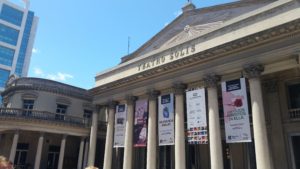
We arrived 2.5 hours later in the capital, Montevideo. We booked our stay at MedioMundo Hostel, which only recently opened, at a reduced rate of $53 CAD/night. It’s a nice place but rather small, making it good for socializing. The hostel was nice and it was a great place to socialize with other travelers but the location was a little off the beaten path and we had to walk endlessly to find an open restaurant to eat at. We even asked the hosts for some recommendations on where to eat and they seemed puzzled as well. If you stay closer to the downtown there are much more options.
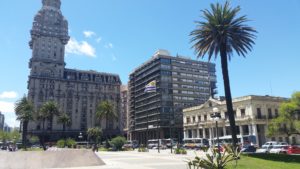
There are daily walking tours starting at 11 AM in the Plaza Independencia (unless it’s raining), and this is something we highly recommend. This may be one of the best guides we’ve had. With an absolute lack of traditional ‘tourist attractions’ our guides sense of humour was what made the tour so worth it. He didn’t sugarcoat anything and was very honest about the views that most Uruguayans have. His anecdotes were priceless and even pointed Clair in the direction of the one “good” coffee shop in the city. In his words “It’s not because Uruguayans feel strongly about any of these things, it’s just that we don’t really care about any of these things. Except the Uruguayan futbol team.”
Day 6-9 – Punta del Diablo
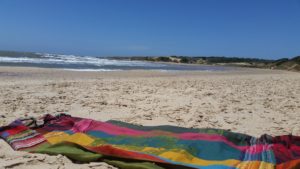
We were eager to venture off from the big city lifestyle so we skipped over the most often visited Punta del Este and headed straight to the less traveled (but it won’t be for long) Punta del Diablo. (Pro tip – If you make your way to these beach towns, make sure you have plenty of cash. There are no ATM’s or banks around and only a hand full of places accept credit cards.) There are a number of buses that head this way but you may have to buy a ticket to Chuy which is a border town near Brazil. Keep your ears open and they’ll let you know when you’ve reached Punta del Diablo and you can just get off there. It’s about a 30 minute walk into town. Brazilians and Argentinians flock here during the high season between December and March. We arrived just prior to the rush, so prices for accommodations were significantly lower, however this also meant that most restaurants weren’t open for the season yet. We booked a private room for two nights at El Diablo Tranquilo Hostel for $45.00 CAD/night. The hostel offered a free beer for anyone returning a bag of garbage from the beach. We thought this was a great promotion for travelers to help clean up the area.

Kik – “Did someone say free beer?”
There are three beaches in the area, but Playa Grande is the furthest and nicest. If you’re up for a hike, turn left from the main beach, keep walking past the rocks (there’s a sandy path that you can take) and keep going until it opens up. It’s worth it!
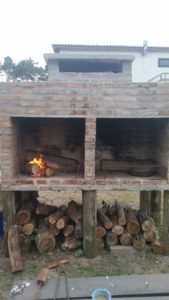
Two days wasn’t enough for us so we shacked up at a great cabin style apartment at Mandala de mar for a reduced rate of $39 CAD/night. We would strongly recommend checking out the Air B&B’s in the area over a hostel. Our host, Hernan, was a younger Argentinean who has permanently moved to Punta del Diablo. He was incredibly friendly, and even drove us to the bus station which is quite a far walk away from town. We had access to using the outdoor Uruguayan parilla (BBQ). Instead of coal this BBQ relies on embers from a fire to grill the meat.
Day 10 – Return to Montevideo
We almost didn’t leave Punta del Diablo, and not because we didn’t want to (although in all honesty, we didn’t want to!) but we literally had 11 pesos left. We were aware there were no ATMs but unfortunately didn’t anticipate staying a few days longer and we had been told we could pay for our bus tickets with our credit cards. Here’s the tricky part. When you get the bust station there are three companies that you can choose from. When we arrived only two of the windows were staffed with a sign on the non-staffed window to see the neighborliness teller for service. Great! So we follow the instructions on the sign and ask to purchase two tickets on the next bus. She then instructs us that this company (COT) does not accept credit cards. Momentary panic attack. Finally, after watching us sweat for about 15 minutes the same teller says that the company she works for does. S0…in a nutshell. There is one company in that bus station where you can (at time of writing) pay for a ticket with a credit card from Punta del Diablo to Montevideo ($30 CAD/pp). With a quick night in Montevideo before we returned in Argentina we stayed at a really well organized hostel, Che Lagarto. It’s really close to the bus station (Tres Cruces). Unfortunately, they only had dorms but it was clean, offered a great breakfast, and for a great price of $15 CAD/bed it worked for the night. Clair slept in her jumper.
Hi Clair and Christian,
Thank you for sharing with us this truly amazing adventure. This informative and entertaining blog will guide future travellers. It makes us miss you less when we hear about the many places you have visited the lifelong stories you will share and the worldly wisdom you will have gained. (But I still really miss you). Xxoo
Take me to Uruguay! Sounds fantastic! So under the radar; but sounds like home with a lot of Spanish tropical vibes. I like it.
Be safe. You are amazing travellers with great insights, hints and tips. Love you.
Mom & Dad